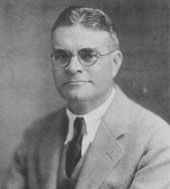Henry V. Hubbard (1875-1947)

Biography
Hubbard, a native of Taunton, MA, received his A.B., A.M., and S.B of Landscape Architecture degrees from Harvard University in 1897, 1900, and 1901 respectively; he studied there under Frederick Law Olmsted, Jr. Afterwards, he also studied architecture at MIT. After completing his education, he joined the Olmsted Brothers firm for several years, including formative travels in Europe with Olmsted himself.
In 1906, Hubbard left Olmsted Brothers to form his own firm, Pray, Hubbard & White. In the meantime, he became a lecturer in landscape architecture at Harvard in 1910, later becoming an assistant professor, professor, and Chair in the department. As a professor, he was known for incorporating real-world design problems into the curriculum. In 1910, he formed a new firm in New York, which began publishing Landscape Architecture in that same year. Soon after, in 1911, the journal was named the official publication of the American Society of Landscape Architects.
During WWI, Hubbard was a consulting expert on site planning to the construction division of the army, the Emergency Fleet Corporation, and the United States Housing Corporation. As the war concluded, he edited the technical design volume of the final USHC report. Afterwards, he returned to Boston to teach at Harvard and rejoined Olmsted Brothers as a partner.
While remaining involved with landscape architecture, Hubbard took on a new career focus after the war: city and regional planning. He co-founded and began co-editing the journal City Planning in 1925, and he became a professor of regional planning at Harvard several years later. He would later be a consulting editor to the Planner's Journal.
His continued public service also reflected this change in direction, as he was appointed to succeed Olmsted at the National Park and Planning Commission in 1932. He also acted as a consultant to the Federal Housing Administration and the Public Buildings Administration during WWII. He served as director of the National Planning Institute; President of the ASLA, where he was also a Fellow; Member of the American Institute of Planners; member of the National Capital Park and Planning Commission; and Trustee of the American Academy in Rome.
Sample Projects
Theodore Roosevelt Island National Memorial in Washington, DC, begun 1932 (with Frederick Law Olmsted Jr.)
Plan for the redevelopment of Baltimore, 1945
Sample Publications
An introduction to the study of landscape design, 17 editions published between 1917 and 1967
Landscape architecture ; a comprehensive classification scheme for books, plans, photographs, notes and other collected material, with combined alphabetic topic index and list of subject headings, 5 editions published in 1920
Our cities, to-day and to-morrow; a survey of planning and zoning progress in the United States, 1929.
Source:
Obituary, The New York Times (New York: Oct 8, 1947) pg. 25.
Obituary, Landscape Architecture (v. 38, no. 2, January 1948) pp. 47 – 60.
Charles A. Birnbaum and Robin S. Karson, Pioneers of American Landscape Design, pp. 177-180).
